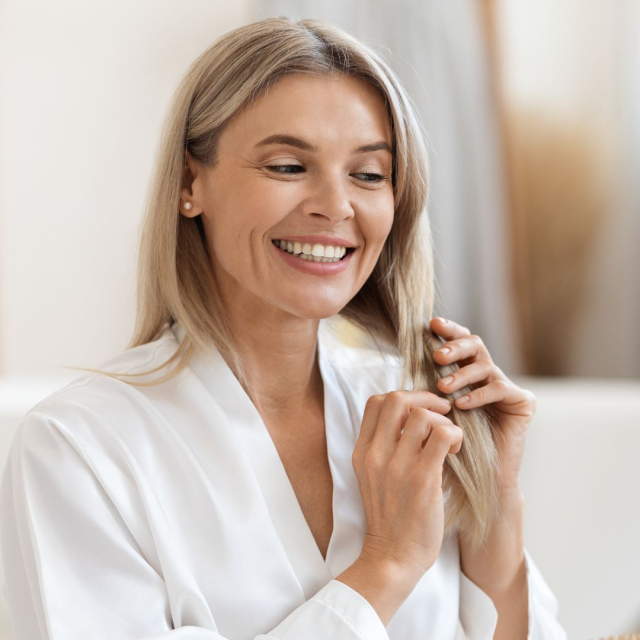Bleaching is a chemical process that can drastically transform your hair, giving it a lighter shade that's ideal for experimenting with vibrant colors or modern styles. However, this procedure can also weaken the hair's structure, leaving it dry, porous, and more susceptible to damage. If you want to have healthy, shiny bleached hair, you need to implement a specific care routine. Below, we present a complete guide with the best tips for caring for your bleached hair.
1. Use products designed for chemically treated hair
One of the most important steps to maintaining bleached hair is to choose products that are formulated specifically for this hair type. Look for shampoos, conditioners, and masks that are sulfate- and paraben-free, as these ingredients can further dry out your hair.
Recommended products:
- Moisturizing shampoos with natural oils such as argan, coconut or avocado.
- Conditioners rich in keratin or proteins to strengthen hair.
- Repairing masks that help seal the cuticle and maintain moisture.
2. Deep hydration: an essential step
Bleached hair loses much of its moisture during the chemical process, so deep hydration is essential to restore softness and elasticity. Incorporate moisturizing treatments at least once a week.
Homemade options:
- Mix coconut oil with honey and apply as a mask for 30 minutes.
- Use mashed avocado combined with a tablespoon of olive oil.
Professional treatments:
- Perform intensive hydration treatments in beauty salons.
- Opt for products with hyaluronic acid to retain hydration.
3. Minimize the use of heat tools
Bleached hair is more fragile, and excessive heat can aggravate the damage. If you must use flat irons, curling irons, or blow dryers, always apply a quality heat protectant.
Tips to reduce damage:
- Use the lowest temperature possible.
- Let your hair air dry whenever possible.
- Invest in tools with ionic or ceramic technology to minimize aggression.
4. Protect your hair from the sun
Prolonged exposure to the sun can cause bleached hair to become drier and the color to fade. Use products with UV filters to protect your hair.
Options to protect yourself:
- Apply hair sprays or oils with sun protection.
- Wear hats or scarves on sunny days.
5. Avoid washing your hair every day
Over-washing can strip away natural oils that help protect your hair. Try to space out your washes and use dry shampoos to keep things fresh in between.
Recommendation:
- Wash your hair 2 to 3 times a week.
- If you sweat a lot or exercise, rinse with water without using shampoo.
6. Make regular cuts
The ends of bleached hair tend to break more easily. Trimming them regularly helps maintain a healthy look and prevents damage from spreading.
Ideal frequency:
- Trim every 6-8 weeks.
- If you don't want to lose length, ask for a minimal trim to eliminate split ends.
7. Take care of the color with specific products
If you have applied a dye or color after bleaching, you will need specific products to maintain the vibrant tone and prevent it from oxidizing.
Key Products:
- Toning shampoos (for example, purple ones to neutralize yellow tones in blondes).
- Conditioners with pigments to revive color.
8. Avoid products with alcohol and other aggressive ingredients
Many hair products contain alcohols that can further dry out your hair. Read labels carefully and avoid those with high levels of alcohol.
Ingredients to avoid:
- Denatured alcohol.
- Sodium lauryl sulfate (SLS).
- Excessive perfumes or synthetic fragrances.
9. Maintain a balanced diet
Hair health depends not only on external care, but also on a diet rich in essential nutrients. Make sure you eat foods that strengthen your hair from within.
Recommended foods:
- Lean proteins (chicken, fish, eggs).
- Omega-3 fatty acids (walnuts, salmon, chia).
- Vitamins A, C and E (carrots, citrus fruits, almonds).
- Biotin (eggs, avocado, nuts).
10. Consult a professional for intensive treatments
If you feel that your hair is extremely damaged, it is important to go to a professional stylist for restorative treatments such as hair botox, protein reconstruction or keratin therapy.
Benefits:
- Repairs the internal structure of the hair.
- Provides immediate shine and a smoother texture.
- Helps reduce frizz and improve manageability.
11. Use cold or warm water to wash your hair
Hot water can open the hair cuticles, leading to further moisture loss. Opt for lukewarm water for washing and cold water for the final rinse, as this seals the cuticles and locks in nutrients.
12. Be patient and consistent
Restoring bleached hair takes time and dedication. Don't expect miraculous results overnight, but with a consistent routine, your hair will significantly improve in texture and appearance.
Remember:
- Be consistent with your care routine.
- Listen to your hair's needs and adjust your products based on its condition.
